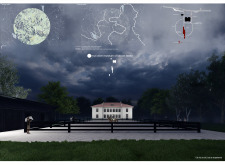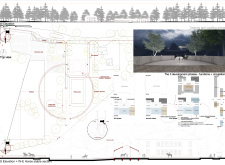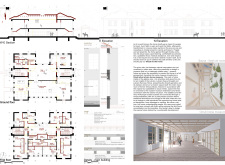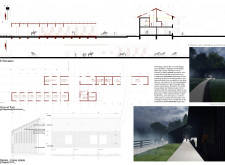5 key facts about this project
The primary function of the museum is to educate visitors about the pivotal role that horses have played in Latvian society through various eras. This is achieved through a series of exhibitions, interactive installations, and community spaces that allow for a deeper exploration of the relationship between humans and horses. The design successfully merges aesthetic value with functionality, ensuring that the museum is both an informative and an engaging environment.
Key elements of the architectural design include a modern yet rustic main building that utilizes large glass panels to enhance natural lighting and create a seamless connection between indoors and outdoors. This approach not only enriches the visitor experience by allowing them to appreciate the surrounding landscape but also contributes to a more sustainable use of energy throughout the day. The careful choice of materials—such as cedar wood for cladding, concrete for stability, and steel for structural integrity—reflects a commitment to quality and sustainability. These materials not only provide longevity and resilience but also resonate with the cultural context of the region.
The museum includes distinct areas dedicated to exhibitions that showcase the rich history of the Latvian horse, allowing for a variety of displays that can incorporate both traditional artifacts and contemporary interactive technology. This focus on experiential learning is a hallmark of the design, emphasizing the importance of visitor engagement in fostering a deeper understanding of the subject matter.
Outside, the museum features well-planned landscaping that integrates cycling paths and green spaces conducive to relaxation and exploration. These outdoor areas enhance accessibility and invite community members and visitors alike to partake in the region's cultural offerings. Additionally, the presence of stabling and training facilities for horses supports the museum’s educational mission by allowing live demonstrations and interactive encounters with horses, reinforcing the link between the exhibits and the living context of the Latvian horse.
A unique aspect of this project is its emphasis on community and social coherence. The inclusion of multipurpose spaces for events and workshops provides a platform for local engagement and cultural exchange, ensuring that the museum serves as a hub for community activities beyond its educational purpose. By creating such a space, the architects have addressed the need for cultural institutions to function as active participants in their communities.
In terms of design philosophy, the project illustrates a balance between homage to historical forms and the integration of modern architectural practices. It respects the traditional values associated with horse culture while embracing contemporary techniques for construction and energy efficiency. This approach allows the museum to celebrate its subject matter authentically while also addressing current environmental and social concerns.
Overall, the Multi Alive Museum of the Latvian Horse stands as a testament to thoughtful architectural design that prioritizes cultural expression and community involvement while emphasizing sustainability. For those interested in a deeper understanding of its intricate design elements, architectural plans, sections, and various architectural ideas are available for exploration. Visitors and architecture enthusiasts alike are encouraged to delve into the project's presentation for an enriched perspective on its unique architectural narrative.


























